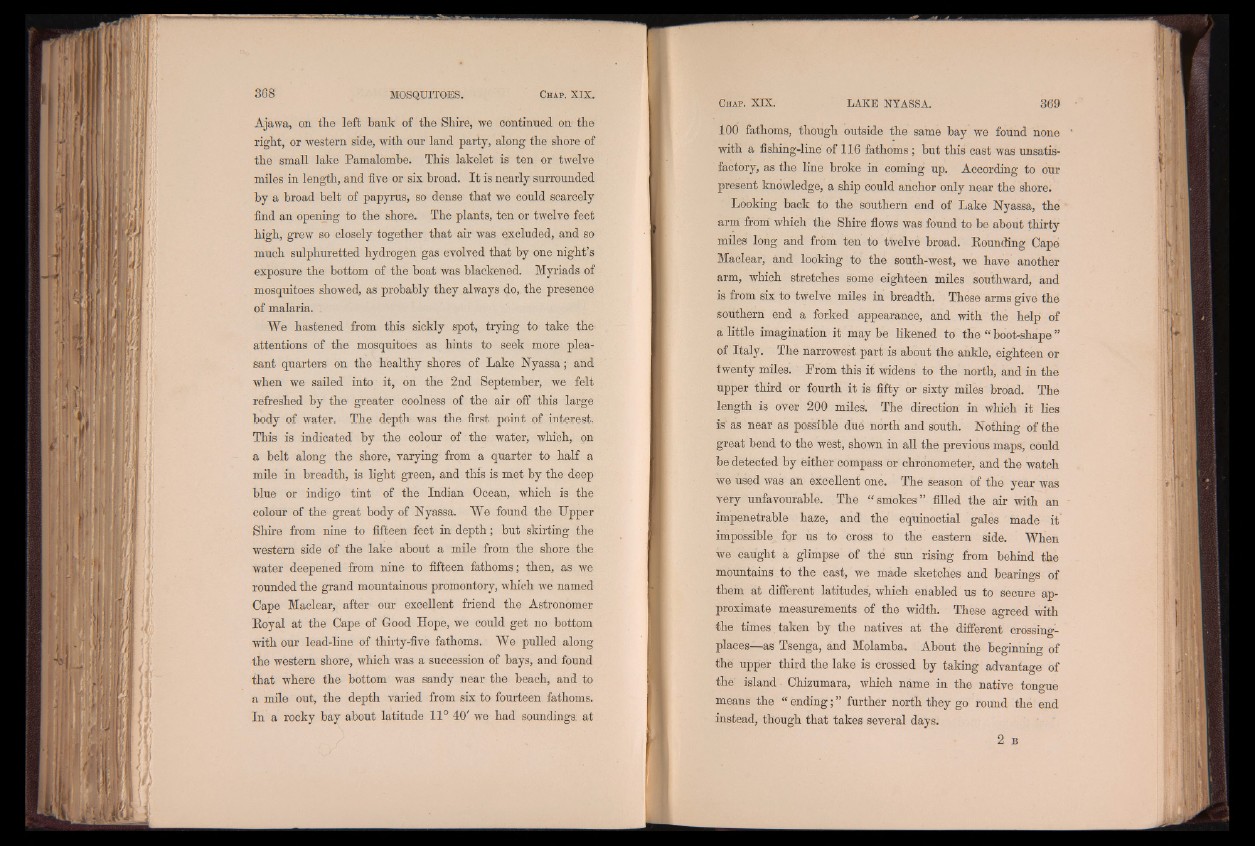
Ajawa, on the left bank of the Shire, we continued on the
right, or western side, with our land party, along the shore of
the small lake Pamalombe. This lakelet is ten or twelve
miles in length, and five or six broad. I t is nearly surrounded
by a broad belt of papyrus, so dense that we could scarcely
find an opening to the shore. The plants, ten or twelve feet
high, grew so closely together that air was excluded, and so
much sulphuretted hydrogen gas evolved that by one night’s
exposure the bottom of the boat was blackened. Myriads of
mosquitoes showed, as probably they always do, the presence
of malaria. ,
We hastened from this sickly spot, trying to take the
attentions of the mosquitoes as hints to seek more pleasant
quarters on the healthy shores of Lake Nyassa; and
when we sailed into it, on the 2nd September, we felt
refreshed by the greater coolness of the air off this large
body of water. The depth was the first point of interest.
This is indicated by the colour of the water, which, on
a belt along the shore, varying from a quarter to half a
mile in breadth, is light green, and this is met by the deep
blue or indigo tint of the Indian Ocean, which is the
colour of the great body of Nyassa. We found the Upper
Shire from nine to fifteen feet in depth; but skirting the
western side of the lake about a mile from the shore the
water deepened from nine to fifteen fathoms; then, as we
rounded the grand mountainous promontory, which we named
Cape Maclear, after our excellent friend the Astronomer
Royal at the Cape of Good Hope, we could get no bottom
with our lead-line of thirty-five fathoms. We pulled along
the western shore, which was a succession of bays, and found
that where the bottom was sandy near the beach, and to
a mile out, the depth varied from six to fourteen fathoms.
In a rocky bay about latitude 11° 40' we had soundinga at
100 fathoms, though outside the same bay we found none
with a fishing-line of 116 fathoms; but this cast was unsatisfactory,
as the line broke in coming up. According to our
present knowledge, a ship could anchor only near the shore.
Looking back to the southern end of Lake Nyassa, the
arm from which the Shire flows was found to be about thirty
miles long and from ten to twelve broad. Rounding Cape
Maclear, and looking to the south-west, we have another
arm, which stretches some eighteen miles southward, and
is from six to twelve miles in breadth. These arms give the
southern end a forked appearance, and with the help of
a little imagination it may be likened to the “ boot-shape ”
of Italy. The narrowest part is about the ankle, eighteen or
twenty miles. From this it widens to the north, and in the
upper third or fourth it is fifty or sixty miles broad. The
length is over 200 miles. The direction in which it lies
is' as near as possible due north and south. Nothing of the
great bend to the west, shown in all the previous maps, could
be detected by either compass or chronometer, and the watch
we used was an excellent one. The season of the year was
very unfavourable. The “ smokes” filled the air with an
impenetrable haze, and the equinoctial gales made it
impossible for us to cross to the eastern side. When
we caught a glimpse of the sun rising from behind the
mountains to the east, we made sketches and bearings of
them at different latitudes, which enabled us to secure approximate
measurements of the width. These agreed with
the times , taken by the natives at the different crossing-
places—as Tsenga, and Molamba. About the beginning of
the upper third the lake is crossed by taking advantage of
the island Chizumara, which name in the native tongue
means the “ ending;” further north they go round the end
instead, though that takes several days.
2 B